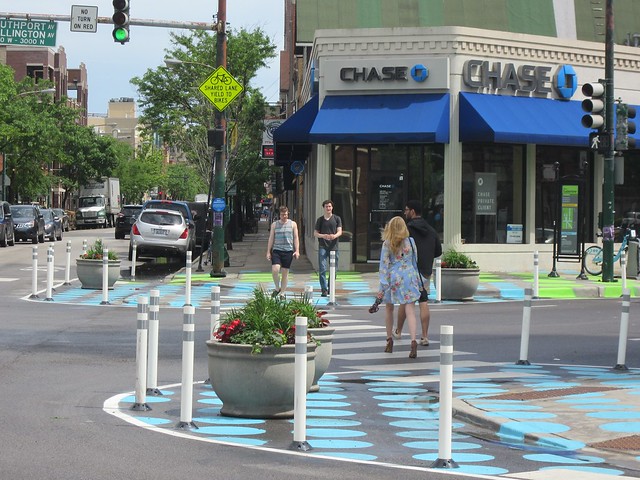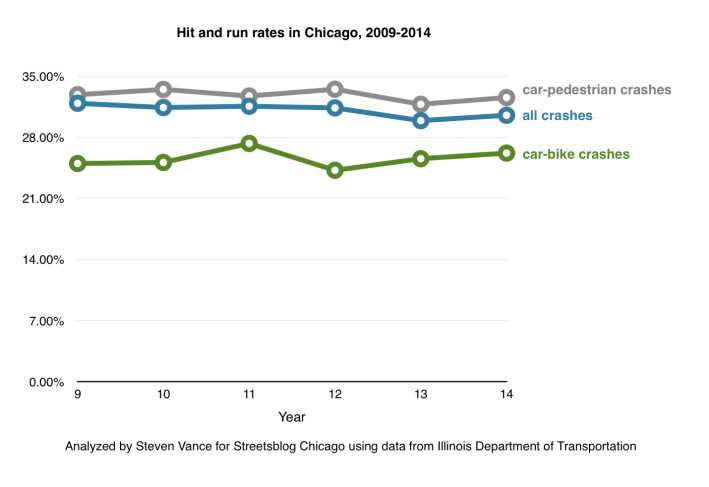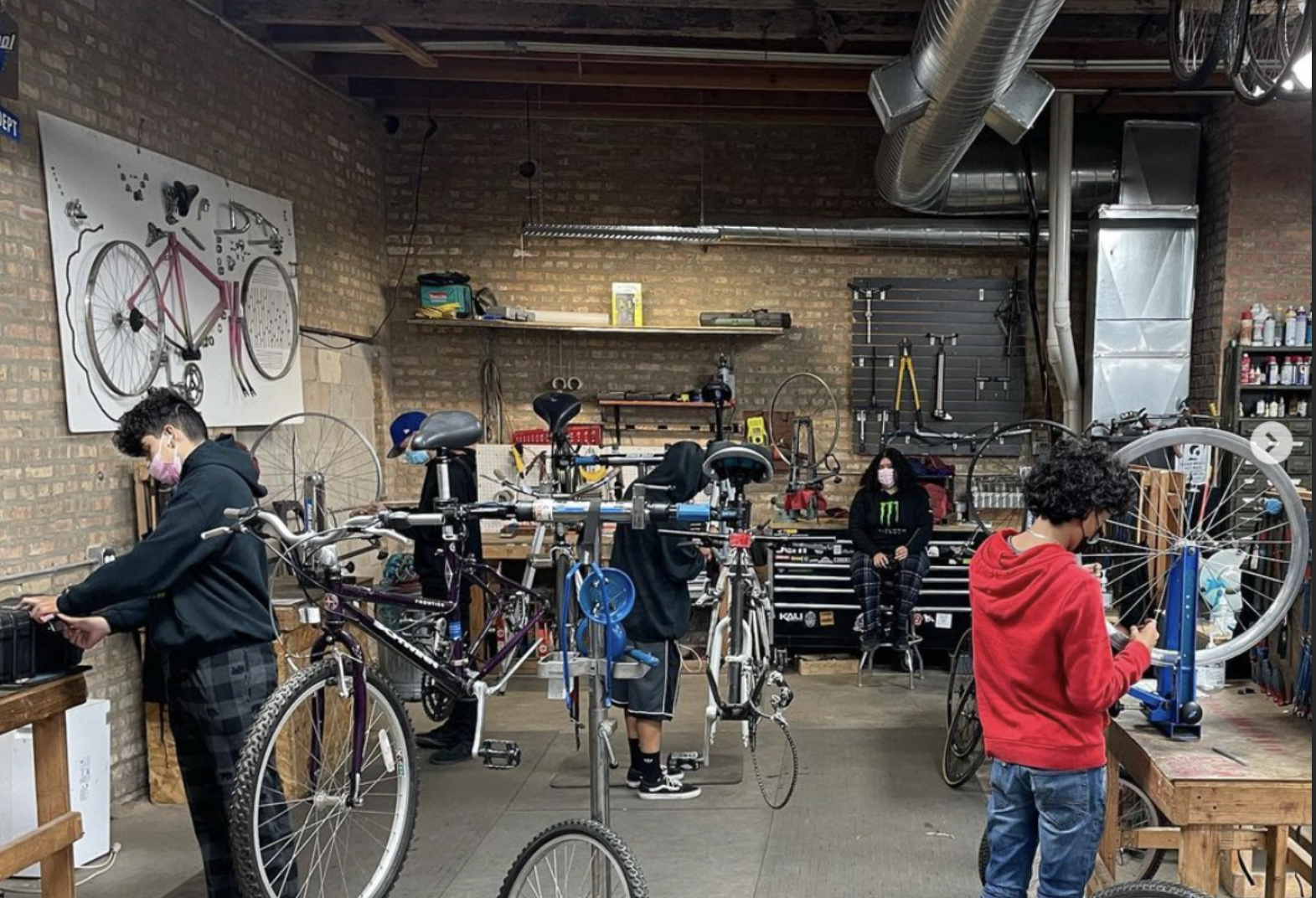Chicago Needs More Street Redesigns to Reduce Pedestrian and Bike Deaths
6:36 PM CDT on July 8, 2016

Last week the National Highway Traffic Safety Administration released a report showing that all traffic fatalities increased significantly on U.S. roads from 2014 to 2015, by 7.7 percent to reach 35,200, the worst death toll since the 2008 economic crash. Streetsblog USA's Angie Schmitt pointed out that, while Americans drove 3.5 percent more during this period, that's "not enough to explain the rising death toll." U.S. pedestrian and bike fatalities rose even more during that period, by 10 and 15 percent, respectively.
Illinois saw a similar 7.5 percent increase in traffic deaths last year, with 923 fatalities in 2014 and 998 deaths in 2015, according to the Illinois Department of Transportation.
In 2015 there were 46 Chicago pedestrian fatalities and 7 biking deaths, according to preliminary numbers from the Chicago Police Department, which may differ from IDOT's final numbers for our city, which won't be released until this fall. That represented a 43.8 percent increase in pedestrian deaths over 32 in 2014, and a 16.7 percent rise in bike fatalities from six in 2014, according to IDOT figures.
At a Mayor's Pedestrian Advisory Council meeting last February, Chicago transportation commissioner Rebekah Scheinfeld acknowledged the spike in pedestrian deaths between 2014 and 2015. However, she said the city's pedestrian fatality numbers for recent years was "still a decrease if you look at a 10-year trend." Despite that long-term decline, I'd argue that the nearly 44 percent year-to-year rise isn't an acceptable number for a city with a stated goal of eliminating all traffic deaths by 2022.
The Chicago Department of Transportation is behind in many of its stated goals to improve pedestrian and bicyclist safety by changing infrastructure, as outlined in the its Chicago Pedestrian Plan and Complete Streets Design Guidelines. For example, in the Pedestrian Plan, published in 2012, CDOT set a target of eliminating all channelized right-turn lanes, aka slip lanes, by 2015 because these enable drivers to make fast turns around corners, endangering pedestrians.
So far I've only heard about slip lanes being eliminated at two Lakeview intersections, Lincoln/Wellington/Southport and Halsted/Grace/Broadway. In both cases the changes resulted in a backlash from motorists, because the improvements to pedestrian safety made it a bit less convenient to drive.

Milwaukee/North/Damen in Wicker Park was the Chicago intersection with the highest number of pedestrian and bike crashes between 2006 and 2012, according to an Active Transportation Alliance review of city studies for their "Safe Crossings" campaign. However, city hasn't made any infrastructure improvements at this location. Additionally, the intersection has its own slip lane that needs to be removed.
A pedestrian scramble traffic signal phase would be a no-brainer for improving safety at this six-way junction. CDOT implemented a scramble downtown at Jackson and State in 2013. Then-commissioner Gabe Klein said at the time that a scramble might not work at the Wicker Park intersection because it might cause too much delay for drivers, but he acknowledged that eliminating some turns for drivers there might improve safety.
In the pedestrian and complete streets plans, the city also mentioned the need to overhaul other complex, six-way intersection but most of these have received zero attention. For example, CDOT said three years ago that it would change the signal timing at Chicago/Milwaukee/ Ogden in River West to improve safety, but this hasn't happened. One notable exception is Belmont/Ashland/Lincoln in Lakeview, which will be getting a significant safety improvements in the near future, including new crosswalks and bump-outs to shorten crossing distances. Changes on South Chicago Avenue in the South Chicago neighborhood were relegated to the segments between its five and six-way intersections – crossing distances are just as long, despite the road diet CDOT applied.
The department has also been slow to implement another kind of signal change mentioned in the pedestrian plan: Re-timing left-turn signals for cars at pedestrian-heavy intersections so they're at the end of the green phase instead of the beginning. This would eliminate the problem of pedestrians from stepping into the street at the start of the green, assuming it's safe to cross, only to realize that they don't yet have a walk signal and are in danger of being struck by left-turning vehicles.

Finally, our city needs to address our unacceptably high hit-and-run crash rate, which has been roughly the same year after year. From 2009 to 2014, the percentage of crashes in which a driver hit a pedestrian and fled the scene ranged from 31-34 percent. The percentage of crashes where drivers fled after hitting bicyclists ranged from 23 to 27 percent during this time, while the overall hit-and-run rate ranged between 30 and 32 percent. Over half of the 13 pedestrians fatality cases that have occurred so in 2016 involved hit-and-run drivers.
Streetsblog Chicago will be on vacation from July 11-15 and resume regular publication on the 18th. Have a great week!
This post is made possible by a grant from the Illinois Bicycle Lawyers at Keating Law Offices, P.C., a Chicago, Illinois law firm committed to representing pedestrians and cyclists. The content is Streetsblog Chicago's own, and Keating Law Offices neither endorses the content nor exercises any editorial control.
Stay in touch
Sign up for our free newsletter
More from Streetsblog Chicago
It’s electric! New Divvy stations will be able to charge docked e-bikes, scooters when they’re connected to the power grid
The new stations are supposed to be easier to use and more environmentally friendly than old-school stations.
Today’s Headlines for Tuesday, April 23
Communities United: Reports of Bikes N’ Roses’ death have been greatly exaggerated
According to the nonprofit shop's parent organization, BNR has paused its retail component, but is still doing after-school programming and looking for new staff.




